I originally wrote this article for the September 2009 edition of the ICA Magazine. It turned out that someone had already written a piece that included background to the Britten Clarinet Concerto so instead of potential overlap I provided a completely new item. Here then is this previously unpublished article.
I always get excited when an interesting package drops through the letter box. A couple of weeks ago one such package did. It was the score of the intriguing ‘Movements for a Clarinet Concerto’ by Benjamin Britten, sent to me for review.
Readers may well know of the single movement, of which I have written about in a previous letter, which was recorded by Thea King in the early 90s: Movement for Clarinet and Orchestra on the Hyperion label with the English Chamber Orchestra.
Well now we have a whole concerto.
The story begins in 1941 when Britten was living in New York. The composer had attended a performance of the Mozart Concerto given by the great Benny Goodman. Soon after, the two met and Goodman gave Britten a strong indication that a commission was forthcoming (it would have followed his commission for the Bartok Contrasts) so, virtually straight away, Britten began serious work on the project. In March 1942 however, the composer returned to England and, extraordinarily, the manuscript was impounded by US customs officers as they thought some encoded secrets were hidden within the notation. Some months later, presumably after extremely careful scrutiny, it was eventually deemed safe and dispatched to Aldeburgh. But Britten was now working on Peter Grimes and though he did show some renewed interest in the concerto the following year it was soon filed away – regrettably never again to resurface during the composer’s lifetime.
Nearly fifty years later (in 1990) Colin Matthews (who worked closely with Britten towards the end of his life) completed the single movement which was subsequently recorded by Thea King on her disc of English clarinet concertos. More recently, Matthews had again been drawn to this fascinating work and contemplated reconstructing the complete three movements. The sketches contained nothing that would seem to suggest material for further movements so a more ingenious solution would have to be found. A little known work for two pianos, the Mazurka Elegiaca, which was written at almost exactly the same time as the first movement (the summer of 1941) was chosen as the basis for the slow movement. But what about the third movement? If the piece was to have stylistic cohesion then Matthews needed something else contemporary and appropriate. He went back to the original manuscript and was delighted to discover a substantial sketch for an unfinished orchestral piece (most likely the Sonata for Orchestra which features in a number of Britten’s contemporary letters). It was perfect material for the third movement. And so Colin Matthews set to and soon created the highly effective and engaging work of which I now have a copy on my desk.
The three movements last about seventeen minutes and are scored for clarinet and a large orchestra. The first performance was given by Michael Collins in May 2008 and it is now published by Faber Music. A recording is due out (on the Presto Classical label) in October this year (so should be available by the time you’re reading this!) It’s a great addition to the repertoire. Tuneful and very playable.
Now, some of you may still be wondering about to what exactly the ‘Benn’ part of the title of this letter was referring. Mr Benn is the eponymous hero of a charming children’s TV series. I loved it as a child - especially the music which, as the credits told us, was apparently written by one Don Warren. But in fact it wasn’t. After much careful research I finally discovered that it was written by the well-known saxophone player Duncan Lamont, who wished to keep his duel life as highly-acclaimed jazz artist and composer of children’s TV signature tunes separate. What particularly drew me to the music was the delicious main theme which was beautifully written and scored for bass clarinet and doubled on xylophone accompanied by a small ensemble. Actually Duncan told me he’d originally scored the tune for trumpet, but the trumpet player failed to make the recording session and as there was a spare bass clarinet player about, he re-scored it. Anyway, to cut a long story short I have just arranged and published ten pieces from the series, including the superb title music, for B flat clarinet and piano. (Queen’s Temple Publications, QT 118.) They are simple and absolutely delectable.
So, as we look towards the second decade of the twenty-first century the clarinet repertoire has become the richer through two memorable Bs: Benn and Britten.
Paul Harris 2009

